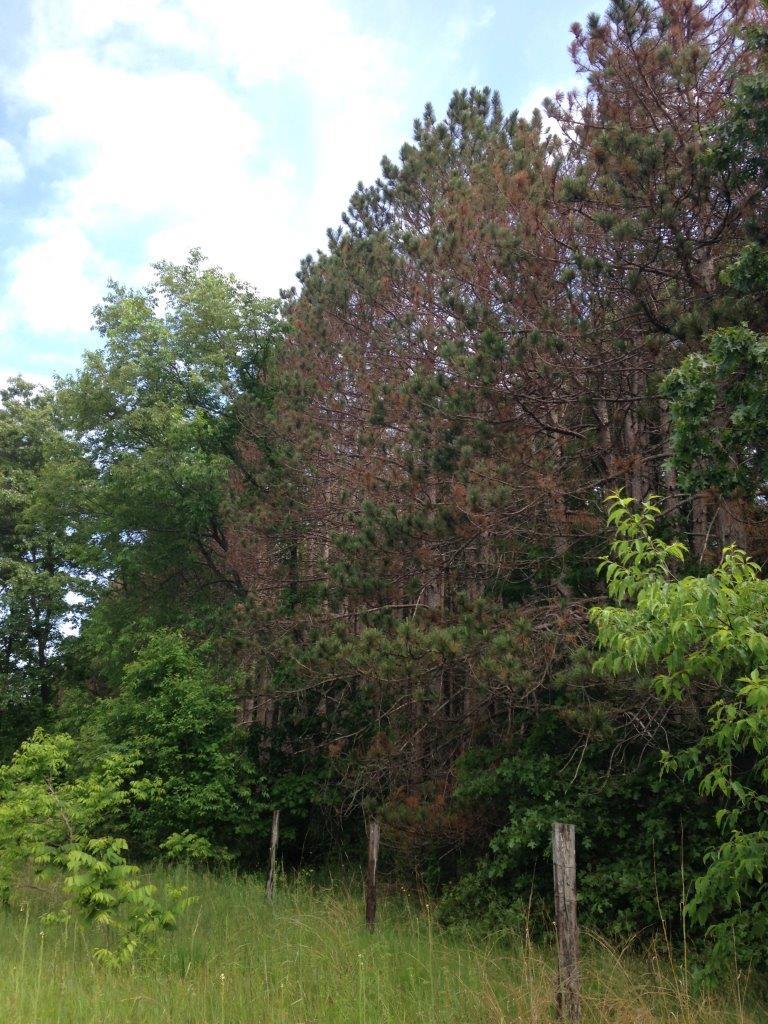White Pine Plantation Will Remain

Several rows of red pines along one edge of the Forest Society's "Floodplain" property's white pine plantation in Concord have succumbed to an infestation of red pine scale. Forest Society photo.
The Merrimack River Outdoor Education and Conservation Area, more commonly known as "The Floodplain,” lies just below the Conservation Center buildings in Concord and provides 80 acres of open space for hiking, swimming or an afternoon nature retreat. The Forest Society purchased this land in 1980 to protect its unique natural communities and wildlife as well as to provide a recreational opportunity adjacent to its headquarters. Situated in the western portion of the property along the banks of the Merrimack River lies a pine plantation. Most visitors walk right through this as they head along the trails to the river or along Mill Brook. This plantation was planted by the previous owners around 1962 with cost-share money from the USDA. Around that time, there was a general push to reforest abandoned fields and open space around the state. Most of the plantation consists of white pine, but the last five to ten rows along the far western edge were planted with red pine. This was at the recommendation of a soil conservationist who felt these trees would add wind protection to the white pine.
Now, 50 years later, the red pine trees are living up to their name and turning red. Just last year, the trees had developed a red hue along the lower canopy. Upon closer inspection by the N.H. Division of Forests and Lands, Forest Health Specialists, it was determined the trees have become infected with an invasive exotic pest, the red pine scale (Matsuciccus resinosae). Just a year later, the scale has infested all of the half-acre of red pines. Many trees have already died, and others are rapidly losing foliage. We anticipate the trees will all be dead within the year.
This bug is native to Japan, and it’s suspected that it came here during the 1939 New York World Trade Fair. It was first detected in Connecticut in 1946 and has since spread to several northeast states. It was first found in New Hampshire in 2012 and has spread to 10 different towns throughout the state.
The red pine scale is about the size of a fleck of pepper. It causes the foliage to turn light green to yellow to red, usually starting in the lower branches of the tree crown and then spreading throughout. You can often see masses of tiny white cottony filaments along the branches when an infestation grows. The bug kills the tree by piercing the bark and sucking on the nutrients that flow along the inside of the bark. The tree eventually succumbs to the tens of thousands of feeding bugs. Mortality occurs within three to five years of infection. The scale is spread through wind or by tagging along on mammals or birds.
There is no effective control for the pest. It has no natural predators in this country and introduction of predators from its native range have proved unsuccessful. Insecticides are expensive and ineffective but there has been some success in protecting individual, ornamental red pines. The best way to control the scale is to remove its food source by cutting the tree down. Once the tree has been cut, the scale quickly dies.
The red pine trees on the Forest Society's floodplain property cover only about a half an acre. One of several hiking trails on the property runs right through the red pine. As the trees began to die, concern over hiker safety became an issue. In 2014, volunteers and staff attempted to close the portion of trail through the red pine and move it into the adjacent white pine stand. Unfortunately, this did little to stop visitors from continually re-clearing and using the original trail. Foresters decided the best course of action would be to cut down all of the dead and dying trees, thereby eliminating the safety concern, and killing off the bugs. The trees will be left on site and remain as insect and wildlife habitat while they decay. This is slated to happen at the end of March 2015.
The N.H. Division of Forests and Lands conducted a similar, but much larger sanitation harvest at Bear Brook State Park in 2013 and 2014. An infestation was discovered in the park’s pine plantations in 2012. The harvest covered about 225 acres and was completed in April of 2014. For more information about this project, please visit the Bear Brook Sanitation Timber Harvest webpage.
For more information about this pest and other forest pests around N.H., visit NH Bugs.
